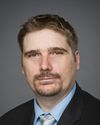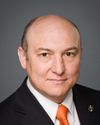Thank you very much.
Everybody should have a copy of our presentation in front of them, hopefully, and bear with me, because it's 15 pages. We'll skim through some of it and we'll concentrate on the important areas.
If you take a look at the Canadian Association for Disabled Skiing, you'll see that we put on winter sports clinics for injured soldiers and veterans, including their spouses. I'd like to talk about the background. We'll talk about who we are nationally and locally, how we got involved, what we are doing, the issues, and our recommendations.
If you go to the third slide, which talks to the background, we have approximately 3,000 members across Canada. We were established in 1976. We are a volunteer and charitable organization. We have snowboard and ski programs in all provinces, excluding Prince Edward Island. Locally, we have five programs, starting at Edelweiss. We have a visually impaired program at Camp Fortune, and about 10 years ago we migrated from the Gatineaus over to Ontario and started programs in Pakenham and Calabogie.
Our mission is to enrich the lives of persons living with disability through adaptive skiing and snowboarding. Notice we didn't say teach them how to ski. In other words, we're looking to enrich their lives, and I think it's important for this committee to understand that.
How did we get involved? It's on the next page. A number of our instructors have been going down to the U.S.A. Disabled Veterans Winter Sports Clinic in Colorado. They're in their 28th year. My friend Mr. Gilmour has been going down for 24 years. Unfortunately, I've only gone down for three or four years.
A number of instructors from Canada took a look at that, a model that was going on down there, putting 400 injured soldiers and veterans through such things as skiing, snowboarding, biathlon, cross-country skiing, scuba diving, wall climbing, and self-defence clinics, and learning what they can do with their new bodies and developing peer and mentor relationships. We said, “Let's see if we can migrate this program to Canada for our boys and women.” And we've done it. It's the sixth year for the program in Mount Washington, in British Columbia; for Calabogie Peaks it's our fourth year, and then there are a couple of others as well.
The next page shows a picture of 2012, with Walter Natynczyk, the Chief of the Defence Staff.
If you go to the next page, we'll get to the winter sports clinic overview. We've worked with 125 Canadian Forces members over the past years as a Canadian association. I think it's important to note that learning to ski and snowboard is not our main objective; it's rather that clinics have a physical and mental therapeutic value, allowing our injured soldiers and veterans to learn what they can do with their new bodies, resulting in higher self-esteem and developing peer and mentor relationships. That's really what we're trying to do here.
We also allow for the individual sharing of personal and family impacts related to trauma injuries. Last year this became very apparent, with one of the soldiers describing the impacts on his personal life. It's very personal, and yet I think we all agree that it becomes part of the healing process when you can verbalize those emotions and the things that happened to you.
I'd like to talk about what we do at Calabogie, and this is the same with all of our winter sports clinics right across the board. Our priorities are safety, fun, and learning how to ski. Safety is first, and if you ain't having fun, you ain't going to learn, okay? It's as simple as that.
We want to ensure success, so we take baby steps, if you will. We don't take people to the top of the mountain and say, “Here you go”, as many of us might have learned how to ski way back when, when our friends abandoned us at the top of the mountain. We'll start at the bottom of the mountain, on the learning slopes, ensuring success all the way. We don't want to have failure and then go back. It's very important and critical in this process.
We do more than just skiing. We have the participants doing social events. We introduced sledge hockey, adaptive swimming, and other events, just to keep the cycle going, and we had a lot of fun doing it. I'll tell you that sledge hockey, with the national development coaches for Canada's sledge hockey team, was a huge success last year, and this year we're introducing biathlon.
Several spouses accompany the soldiers, and we may want to talk to how they can become part of the therapeutic process as well.
The next page takes a look at a number of our injured skiers. You'll see three-track skiers and, although it might not be readily noticeable, below-knee amputees, above-knee amputees.
I would like to note that the picture on the bottom left is a fellow in a sit ski. It's an amazing story, because when he first came to us he was about four months post injury; he lost both legs above the knee, and quite honestly, he was very depressed. He thought his world as he knew it had ended. We put him in a sit ski, and we had a pretty rough year with him the first year. He had a lot of falls, but he mastered it somewhat. He left that year and we wondered if he would be back. Son of a gun, he came back, and the next year we developed the skill sets and really worked with him and balanced his equipment and so forth, and he became very good that year. The following year, last year, we put him in a custom sit ski, and this guy is now just ripping down the hill and ripping down all the hills across Canada. He's has a new raison d'être in his life.
That's what we're trying to do here. That's just one story of many.
We're getting positive feedback from all attendees, including their spouses.
We've introduced a new prosthesis in Canada called the Bartlett tendon universal knee, which allows above-the-knee or single-leg amputees to ski with two skis, instead of three-tracking down a hill. Amazing. Not only can they ski with two skis, but they can use the same prosthesis on bicycles and for doing scuba diving and so forth. Amazing things happen when you can migrate some of the technologies from the United States, and that's what Bob brings back quite a bit.
Some accomplishments listed are an improved outlook on life, especially for soldiers with OSI, and there are lot of soldiers there. There's the personal sharing of stress and issues. Finally, there are proven fundraising capabilities by our volunteers. This year we are on target to raise over $75,000 just for our winter sports clinic at Calabogie.
Here's a participant letter of appreciation. I think in this letter the only thing I wanted to note was a line where Jim Hapgood, a retired warrant officer in Newfoundland with OSI, says, “Living, as I do, in a small military community it is easy to feel alone at times in what I'm going through. This week has shown me that I'm never alone.”
Those are the peer and mentor relationships we're talking about.
Finally, we get to the important part, and that's the issues as we see them. First is planning. We need promotion and support from the military to canvass for participants. Our ratio of attendees to potential participants is extremely low. We've been told in this catchment area there should be 450 soldiers with OSI or disability injuries.
Timing, funding.... Volunteers and instructors, of course, we can get here. We've got a fairly good bunch in that regard.
Finally, it's a great opportunity for positive media relations. We think Calabogie is an ideal location—and we're going to blow our horn here a little bit—because it's got lodging, indoor pools, exercise rooms, and everything is located at the base of the hill. Your soldiers aren't travelling for an hour to get to their location. It's all right there for them, including all the social activities and the biathlon activities.
We recommend that we continue to hold an annual winter sports clinic in the east and in the west. We recommend maximizing military participation. I'd like to talk about that. We'd like to address potential roadblocks preventing access to potential participants. In other words, how do we get at the participants? And WSC, our winter sports clinic, should become a DND-approved event so that soldiers can attend while on duty. I think that's important, versus taking holidays.
Finally, in addressing planning issues, I think reviewing spousal support is a big one. The other one is that it seems we abandon our veterans after they're discharged from the service.
We think maybe there's a better model here, one where we can start serving our veterans as well.
All that being equal, that is the vision and growth: to continue to expand—the fourth year at Calabogie, the sixth year at Mount Washington—and to continue to grow this program.












